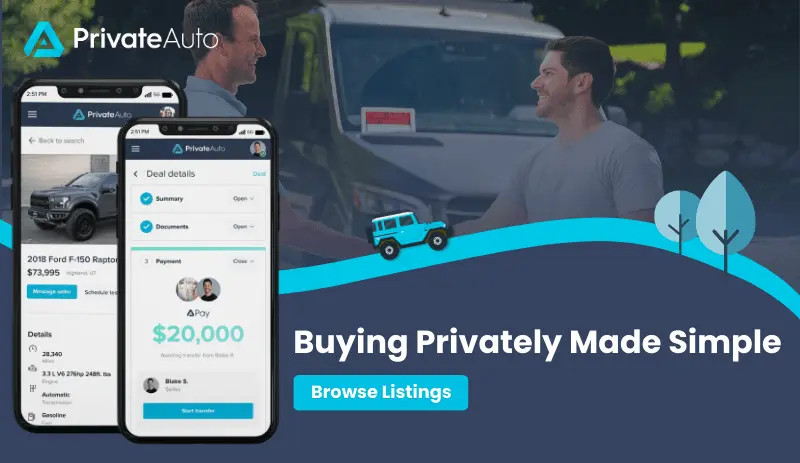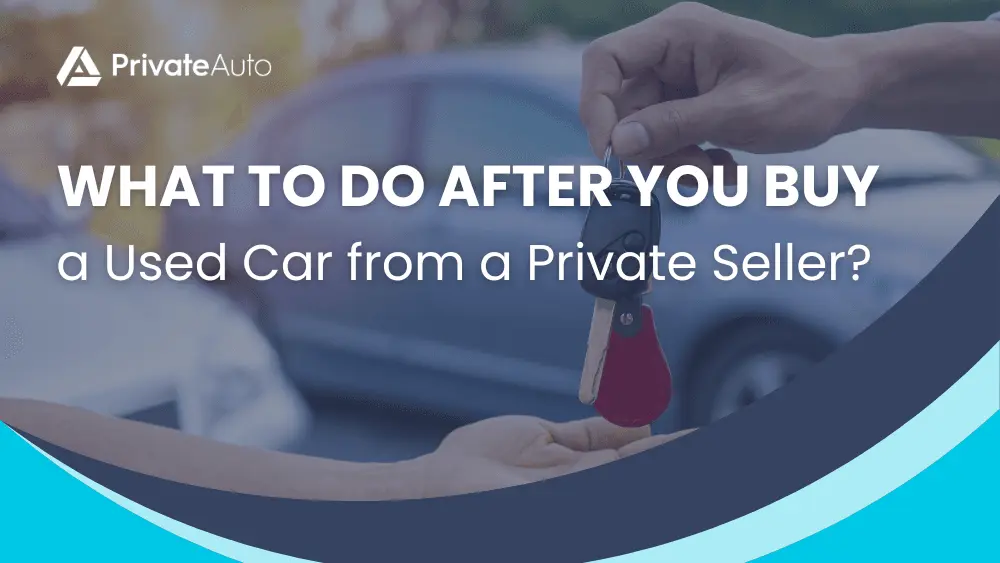1.Emissions testing
Step 1: Get Emissions Testing

2. Finalize with the DMV
Step 2: Finalize with the DMV
Pay Sales Tax
Transfer the Title
- A completed vehicle title transfer form
- Proof of auto insurance
- Proof of identity (driver’s license or government-issued ID card)
- Bill of sale—done through the PrivateAuto mobile app with e-signatures
- The original title (or a duplicate title, if the original one was lost)
- An odometer disclosure statement—required by some states
- A highway safety inspection—required by some states
- Proof of payment for your state’s car sales tax (if applicable)
Register the Car
- Personalized plates with custom letters/numbers
- Specialty plates showcasing causes like parks or universities
- Premium plates made of materials like stainless steel
3. Contact your insurance company
Step 3: Follow up with your Insurance Company

4. Update personal records
Step 4: Update Personal Records
Update any personal records and accounts that may be linked to your vehicle information. This ensures that all your vehicle-related matters are current and accurate.
1. Parking permits: if you have residential or workplace parking permits, update them with your new vehicle’s information to avoid potential tickets or towing.
2. Toll tags and transponders: if you use electronic toll collection systems such as E-ZPass, FasTrak, or SunPass, update your account with the new vehicle’s make, model, and license plate number.
3. AAA or roadside assistance: if you’re a member of an auto club or have roadside assistance, update your account with the new vehicle details to ensure seamless service if needed.
4. Work records: if you use your personal vehicle for work or receive any vehicle-related benefits from your employer, inform your HR department of the change.
5. Online accounts: update any online accounts where you’ve previously stored vehicle information (e.g., auto parts retailers, car wash subscriptions, etc.).
6. Emergency contacts: if you keep an emergency information card in your vehicle, create a new one with your current vehicle details.
Buying a Car From a Private Seller FAQ
How many days do you have to insure a used car after purchase in California?
After purchasing a used car in California, you have 10 to 30 days to insure the vehicle.
How long do you have to register a car after purchase in California?
In California, you have 10 days to register a newly purchased vehicle with the Department of Motor Vehicles (DMV) if bought from a private party.
When I buy a car from a private seller, can I drive it home in Florida?
You can drive a car home after buying it from a private seller in Florida if you get temporary insurance coverage.
Should I do a vehicle inspection before or after purchasing the car?
Before you say yes to the car, you should inspect it. Even better, arrange a professional pre-purchase inspection.
You can order a pre-purchase inspection in your PrivateAuto service hub and a Lemon Squad inspector will come to your location.
Here are some of the things your Lemon Squad inspector will examine. Or, if you’re attempting to perform your own inspection, here’s what to look at:
– Undercarriage: inspect the car for leaks, rust, and damage. Look at brake lines, exhaust, and suspension components.
– Tires: examine tire treads and make sure there is sufficient tread depth. Also look for any cracks, bulges, or other tire damage. Check the spare as well.
– Body: check for obvious damage, body panel alignment, uneven gaps, mismatched paint, and signs of damage repair. Look closely for any indications of collision repair. Check for rust underneath and around body panels. Check headlights, brake lights, and other lights.
– Fluids: check all fluid levels, including engine oil, transmission fluid, brake fluid, power steering fluid, and coolant. Look for leaks and make sure the fluids look clean and at proper levels.
– Interior: ensure all controls, electronics, air conditioning, and heating work properly. Look for any warning lights on the dash when the car is started. Check for water damage, stains, or tears inside.
– Test drive: drive the car under different conditions to test acceleration, braking, steering, and transmission, and to feel and listen for any mechanical issues.
– Maintenance records: review the vehicle history report and check maintenance logs to understand repair and ownership history.
How do I avoid buying a faulty car?
The best way to avoid buying a faulty car is to get a vehicle history report.
We have partnered with AutoCheck to provide vehicle history reports on premium listings. AutoCheck gets its data from the following sources:
– Salvage auctions.
– Collision repair shops.
– Service records from maintenance facilities.
– OEM manufacturers.
– Car dealerships and extended warranty companies.
– Auto auctions.
– State Departments of Motor Vehicles (DMVs).
– Insurance companies.
– Vehicle inspection and state inspection stations.
– Import and export companies.
– Rental and fleet companies.
Running an AutoCheck on a vehicle uncovers valuable insights into the car’s background.
– Regular maintenance (or lack thereof).
– Title history: salvage titles, junk titles, flood damage, hail damage, storm damage, fire damage, and more.
– Lien information, ownership transfers.
– Manufacturer buybacks or lemon titles.
– Collision repair history.
– Structural or frame damage.
– Service, repair, and maintenance performed.
– Total loss and reason for the loss.
– Stolen cars.
– Major repairs.
– Open recalls.
– City and state of previous registration, number of owners.
– Accidents and damage reports, stolen vehicles.
– Rental, taxi, lease, or government use.
– Emissions records.
– Odometer rollback.
– And lots more…
Can I pay for a car with a credit card?
Credit cards are a terrible way to pay for a private-party car. Credit card companies charge exorbitant interest rates, and even if you pay your balance off within 30 days, you’ll still have to pay a bunch of fees to Stripe or some other credit card processor. And then there’s the hassle.
Is paying with a check better than paying in cash?
Many buyers prefer a cashier’s check rather than paying for a car with physical cash, which is risky and cumbersome. A cashier’s check holds more credibility than a personal check. However, unless you’re in the issuing bank during business hours and they verify the funds, the seller—if they’re smart—won’t see it as foolproof. Criminals have forged cashier’s checks to con sellers.
To be absolutely sure your cashier’s check is valid, some sellers wait for it to clear their bank before releasing the title. This puts pressure on you to pay a large sum while trusting the seller to sign over the car later. It also means meeting twice, which is inconvenient.
PrivateAuto is safe, instantaneous, and guaranteed. With PrivateAuto Pay, funds instantly appear in the seller’s account. The entire transaction can be concluded when you meet for a test drive.
Which day of the week is best to buy a car?
When you find the perfect car for sale by owner at the right price, that day is the best day to buy a car. With PrivateAuto Pay, you can buy a private-party car any day, any time.
How can I stay safe when meeting up for the test drive?
Platforms force you to exchange contact info with a stranger to schedule the test drive. The best way to stay safe is to use PrivateAuto. If that is not an option, always meet in a public space such as a grocery store parking lot or in front of a bank.
Do I need a notary public when buying a car from a private seller?
Some states require a notary public to notarize a private-party car transaction. Check with your DMV (or equivalent agency for your state) to see if your state requires notarization.
